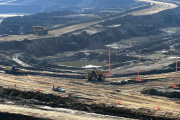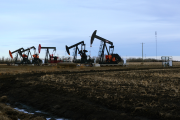Ever since a reported 1,600 waterfowl died in a Syncrude tailings pond in 2008, it has been apparent that the toxic sludge byproduct of oilsands activity needs to be managed better.
Yet, seven out of nine plans filed with the provincial regulator do not appear to comply with rules issued by the provincial Energy Resources Conservation Board (ERCB). What is baffling is that key players in our largest industry seem to think the rules developed to protect Albertans and the environment do not apply to them.
Oilsands industry’s dirty secret
Tailings have long been the dirty secret of the oilsands industry. Now covering 130 square kilometres — an area the size of Vancouver — and growing at a rate of 1.5 million barrels of toxic waste per day, tailings ponds are a byproduct of the oilsands extraction process. After the duck deaths last year, the ERCB issued rules to finally start dealing with these toxic tailings, perhaps as a result of relentless negative international media attention. In September, all oilsands mining companies were required to submit tailings management plans to report how they were going to comply with the directive’s strict requirement to thicken tailings waste and more rapidly reclaim these toxic ponds.
Yet, a review of the nine plans found only two were aiming to comply. Some were not in compliance, others argued they should be given flexibility in when and to what degree they should have to comply. A few plans stated they were compliant with the “spirit” of the directive since they would catch-up with the requirement to deal with this toxic liability — as much as 40 years after it was required.
The two plans that have submitted apparently compliant plans demonstrate that technologies are available to deal with toxic tailings. However, despite economically viable alternatives existing, the industry has long resisted addressing this problem.
The ball is in ERCB’s court
We are curious how the ERCB will respond to the seven non-compliant plans submitted. After all, would a bank find it acceptable for me to state that I was fulfilling the spirit of my mortgage if I paid them the lump sum I owed them after 40 years of not paying? In effect, major oilsands players are being defiant, and they have the nerve to propose expansions even before they demonstrate they can meet basic environmental standards.
The ball is now in the court of the ERCB to determine how to enforce the current rules. Just as oilsands executives have argued they should be exempt from rules to reduce greenhouse gases and Syncrude refuses to accept responsibility for the waterfowl it killed and is fighting these charges in court, this is further evidence of an industry that is out of touch with Canadians expectations for responsible development. Is it surprising, then, that half of the Canadians in a poll conducted by the Canadian Association of Petroleum Producers say they don’t trust oilsands executives?
The ERCB has an opportunity to stand up to oilsands mining industry and ensure that the environmental rules are followed. For the sake of future Albertans, and our current international reputation, we hope they stand firm.
Terra Simieritsch is a Calgary-based oilsands policy analyst with the Pembina Institute. You can read Pembina’s assessment of the tailings plans filed with the ERCB in the report Tailings Plan Review.




